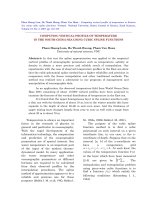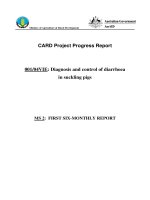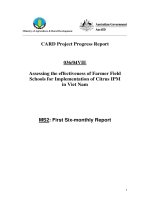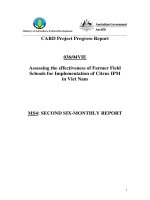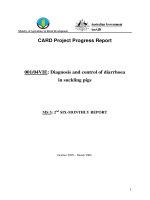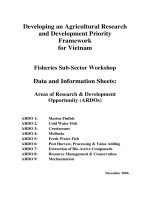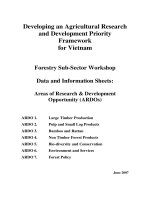Báo cáo nghiên cứu khoa học: " NEURAL NETWORK CONTROL OF PNEUMATIC ARTIFICIAL MUSCLE MANIPULATOR FOR KNEE REHABILITATION" pps
Bạn đang xem bản rút gọn của tài liệu. Xem và tải ngay bản đầy đủ của tài liệu tại đây (688.89 KB, 14 trang )
Science & Technology Development, Vol 11, No.03- 2008
Trang 16
NEURAL NETWORK CONTROL OF PNEUMATIC ARTIFICIAL MUSCLE
MANIPULATOR FOR KNEE REHABILITATION
Tu Diep Cong Thanh, Tran Thien Phuc
University of Technology, VNU-HCM
(Manuscript Received on November 01
st
, 2007, Manuscript Revised March 03
rd
, 2008)
ABSTRACT: An interesting alternative to electric actuators for medical purposes,
particularly promising for rehabilitation, is a pneumatic artificial muscle (PAM) actuator
because of its muscle–like properties such as tunable stiffness, high strength to weight ratio,
structure flexibility, cleanliness, readily available and cheap power source, inherent safety
and mobility assistance to humans performing tasks. However, some limitations still exist,
such as the air compressibility and the lack of damping ability of the actuator bring the
dynamic delay of the pressure response and cause the oscillatory motion. Then it is not easy to
realize the performance of transient response of PAM manipulator due to the changes in the
physical condition of patients as well as the various treatment methods.
In this study, an intelligent control algorithm using neural network for one degree of
freedom manipulator is proposed for knee rehabilitation. The experiments are carried out in
practical PAM manipulator and the effectiveness of the proposed control algorithm is
demonstrated through experiments with two conditions of patient and three kinds of treatment
methods.
Keywords: Knee rehabilitation, Pneumatic artificial muscle, Intelligent control, Neural
network
1. INTRODUCTION
There is an increasing trend in using robots for medical purposes. One specific area is the
rehabilitation. There is some commercial exercise machines used for rehabilitation purposes.
However, these machines have limited use because of their insufficient motion freedom. In
addition, these types of machines are not actively controlled and therefore can not
accommodate complicated exercises required during rehabilitation. An interesting alternative
to electric actuators for medical purposes, particularly promising for rehabilitation, is a PAM
actuator. PAM is a novel actuator which has greater proximity to human operator than the
others. Besides, it inherits advantages from pneumatic actuator such as: cheap, quick respond
time, simple execution (Table [1]), the most important characteristic of PAM which makes it
an optimizing actuator for medical and welfare fields is the human compliance. However, the
complex nonlinear dynamics of PAM make it challenging to realize the transient with respect
to the changes in the physical condition of patients as well as the various treatment methods.
In order to realize satisfaction control performance of PAM manipulator, many control
strategies have been proposed. Starting with linear control techniques, the strategy of PID
control has been one of the most sophisticated methods and frequently used in the industry due
to its simple architecture, easy tuning, cheap and excellent performance [1-2]. However, the
conventional PID is difficult to determine the appropriate PID gains in case of nonlinear and
unknown controlled plants. Various modified forms of this control strategy have been
developed to improve its performance such as: an adaptive/self-tuning PID controller [3], self-
tuning PID control structures [4], self-tuning PID controller [5], self-tuning predictive PID
controller [6], and so on Though satisfactory performance can be obtained and the proposed
controllers above provide better response, these controllers are still limited because of the
TẠP CHÍ PHÁT TRIỂN KH&CN, TẬP 11, SỐ 03 - 2008
Trang 17
limitation of capability of learning algorithm, automatically tuning control parameters and not
yet handling nonlinear characteristic
To overcome these deficiencies, intelligent control techniques have emerged as highly
potential methods. One of these novel intelligent theories includes well-known artificial neural
network. There are many successful commercial and industrial applications using neural
network based controlling techniques in recent years. A Kohonen-type neural network was
used for the position control of robot end-effector within 1 cm after learning [7]. Recently, the
authors have developed a feed forward neural network controller and accurate trajectory was
obtained, with an error of 1[
0
][8]. An intelligent control using a neuro-fuzzy network was
proposed by Iskarous and Kawamura [9]. A hybrid network that combines fuzzy and neural
network was used to model and control complex dynamic systems, such as the PAM system.
An adaptive controller based on the neural network was applied to the artificial hand, which is
composed of the PAM [10]. The controller adapts well with changing environment and shows
good capability in managing complex nonlinearity of PAM. Here, we are going to apply this
strategy into the knee rehabilitation device in the endeavor of automating medical systems and
proving utilities of the proposed controller.
The organization of the paper is as follows: Section 2 is about the knee rehabilitation
experimental setup. The proposed controller is mentioned in section 3 with structure and
learning algorithm while the experiment results are taken up in section 4. Section 5 will
conclude the paper.
2. EXPERIMENTAL SETUP
Recently, there are some commercial knee rehabilitation devices. These devices are
excellent both in model and operations. However, there are still some limitations mainly
originating from the very nature of the actuator – motor, which is lack of human compliance
and make it potentially harmful to patients. Therefore, the knee rehabilitation device which
uses PAM (FESTO, MAS-40-N-300-AA-MCFK) as actuator is constructed and the
photograph of the device is shown in Fig. 1. The system includes a personal computer which
used to control the proportional valve (FESTO, MPYE-5-1/8HF-710B) through D/A board
(ADVANTECH, PCI 1711). The schematic diagram of the system and working principle can
easily be seen in Fig.2 and Fig.3, respectively. A rotary encoder (METRONIX, H40-8-
3600ZO) is used to measure the angular input from the device and fed back to the computer
through a 32-bit digital counter board (ADVANTECH, PCI 1784). The lists of experimental
hardware are tabulated in Table 2. The external load conditions are considered in two cases:
with and without the patient. The experiments are conducted under the pressure of 0.4 [MPa]
and all control software is coded in Visual Basic program language.
Table 1. Comparison of actuators
Actuator Advantages Disadvantages
Pneumatics
Hydraulics
Electrics
Cheap, quick response time,
simple control
High power/weight ratio, low
backlash, very strong, direct drive
possible
Accurate position and velocity
control, quiet, relative cheap.
Position control difficult, fluid
compressible, noisy
Less reliable, expensive, servo control
complex, noisy
Low power and torque/weight ratios,
possible sparking
Science & Technology Development, Vol 11, No.03- 2008
Trang 18
Table 2. Experimental hardware
No. Name Model name Company
1
2
3
4
5
Proportional Valve
Pneumatic Artificial
Muscle
A/D board
Rotation Encoder
32-bit digital counter board
MPYE-5-1/8HF-710 B
MAS-40-N-300-AA-
MCFK
PCI 1711
H40-8-3600ZO
PCI 1784
Festo
Festo
Advantech
Metronix
Advantech
Fig.1. Photograph of the experimental apparatus Fig.2. Schematic diagram pf PAM manipulator
As being proved above, PAM is an optimistic actuator for medical and human welfare
field and therefore rehabilitation. Nonetheless, it is rarely applied to this field due to the
difficulty in position control.
Fig.3. Working principle of PAM manipulators
TẠP CHÍ PHÁT TRIỂN KH&CN, TẬP 11, SỐ 03 - 2008
Trang 19
3. CONTROL SYSTEM
The strategy of PID control has been one of the sophisticated methods and most frequently
used in industry. This is because that the PID controller has a simple form and strong
robustness in broad operating area. However, the requirement of control precision becomes
higher and higher, as well as the plants become more and more complex. In order to achieve
the satisfactory control performance, we have to consider the effect of the hysteresis and
disturbance of the PAM manipulator. Hence, the conventional PID controller with fixed
parameters may usually deteriorate the control performance. Various types of modified PID
controllers have been developed such as intelligent PID control, self-tuning discrete PID
controller, self-tuning predictive PID controller, and so on [11].
Fig. 4. Structure of proposed controller
However, if severe nonlinearity is involved in the controlled process, a nonlinear control
scheme will be more useful, particularly in case of high nonlinearity of the PAM manipulator.
Nowadays, neural networks have been proved to be a promising approach to solve complex
nonlinear control problems. Hence, it motivates us to combine neural network with PID
control. It is anticipated that the combination will take the advantage of simplicity of PID
control and the neural network’s powerful capability of learning, adaptability and tackling
nonlinearity.
And the input signal of the sigmoid function in the output layer,
x
, becomes:
() () () () ()
() ()
ppii
dd
x
kekKkekKk
ek Kk
=× +×
+×
(1)
Where,
1
1
() () ();
() ()
()(1 )
()
:,
:
:
pref
k
ip
n
p
d
ek k k
ek e n T
ek z
ek
T
T sampling time
k discrete sequence
z operator of Z transform
θθ
=
−
=−
=Δ
−
=
Δ
Δ
−
∑
(2)
()
ref
k
θ
and ()k
θ
are the desired reference input and the output of system, respectively.
Science & Technology Development, Vol 11, No.03- 2008
Trang 20
The control input,
u
, can be obtained from the following equation:
()
1
() (())
1
x
k
uk f xk
e
−
==
+
(3)
To tune the gains of the proposed controller, the well-known steepest descent method
using the following equation was applied:
()
(1) ()
()
(1) ()
()
(1) ()
ppp
p
iii
i
ddd
d
Ek
Kk Kk
K
Ek
Kk Kk
K
Ek
Kk Kk
K
η
η
η
∂
+= −
∂
∂
+= −
∂
∂
+= −
∂
(4)
Where
,,
p
id
η
ηη
are learning rates determining convergence speed, and ()Ek is the error
defined by the following equation:
()
2
1
() () ()
2
ref
Ek k k
θθ
=− (5)
From Eq. (5), using the chain rule, we get the following equations:
() () () () ()
() () () () ()
() () () () ()
p
p
ii
dd
Ek Ek k uk xk
K
uxK
Ek Ek k uk xk
K
uxK
Ek Ek k uk xk
K
uxK
θ
θ
θ
θ
θ
θ
∂∂∂∂∂
=
∂∂∂∂∂
∂∂∂∂∂
=
∂∂∂∂∂
∂∂∂∂∂
=
∂∂∂∂∂
(6)
The following equations are derived by using Eqs. (1), (3) and (5):
()
()
()
() () ()
() ()
'(); ();
() ()
(); ()
ref p
p
p
id
id
Ek
kk ek
uk xk
fxk ek
xK
xk xk
ek e k
KK
θθ
θ
∂
=− − =−
∂
∂∂
==
∂∂
∂∂
==
∂∂
(7)
And the following expression can be derived from these Eqs. (6) and (7).
()
()
()
() ()
() ' () ()
() ()
() ' () ()
() ()
() ' () ()
pp
p
pi
i
pd
d
Ek k
ek fxkek
Ku
Ek k
ek fxkek
Ku
Ek k
ek fxkek
Ku
θ
θ
θ
∂∂
=−
∂∂
∂∂
=−
∂∂
∂∂
=−
∂∂
(8)
TẠP CHÍ PHÁT TRIỂN KH&CN, TẬP 11, SỐ 03 - 2008
Trang 21
and
()
()
()
2
()
(())
1
(())1 (()
xk
xk
e
fxk
e
f
xk f xk
−
−
′
=
+
=−
(9)
As done by Yamada and Yabuta, for convenience,
()
1
k
u
θ
∂
=
∂
is assumed [12]. Then the
Eq. (6) is expressed as follows:
()
()
()
(1) ()
() ()1 (() (())
(1) ()
() ()1 (() (())
(1) ()
() ()1 (() (())
pp
pp p
ii
ip i
dd
dp d
Kk Kk
ekek
f
xk
f
xk
Kk Kk
ekek
f
xk
f
xk
Kk Kk
ekek
f
xk
f
xk
η
η
η
+= +
−
+= +
−
+= +
−
(10)
The effectiveness of the proposed nonlinear PID control strategy with tuning algorithm of
Kp, Ki, Kd will be demonstrated through experiments of position control with three kinds of
treatment methods.
4. EXPERIMENTAL RESULTS
Experiments were carried out with respect to two conditions: without patient and with
patient and three kinds of treatment methods (references are sinusoidal, triangular and
trapezoidal). The comparisons of control performance between the conventional PID and the
proposed controller were also performed.
Figure 5 shows the experimental results of conventional PID controller in two cases of the
patient and with respect to three kinds of treatment methods.
Science & Technology Development, Vol 11, No.03- 2008
Trang 22
Fig.5. Experimental results of conventional PID controller in both conditions
(a): Sinusoidal Reference; (b): Triangular Reference; (c): Trapezoidal Reference
0
10
20
0 20406080
-5
0
5
10
θ [
o
]
Conventional PID Controller
Sinusoidal Reference
Without Load Condition
With Load Condition
Time [s]
(a)
e [
o
]
Without Load Condition
With Load Condition
0 20406080
-5
0
5
0
10
20
e [
o
]
Time [s]
(b)
Without Load Condition
With Load Condition
θ [
o
]
Conventional PID Controller
Triangular Reference
Without Load Condition
With Load Condition
0
10
20
0 20406080
0
5
θ [
o
]
Conventional PID Controller
Trapezoidal Reference
Without Load Condition
With Load Condition
e [
o
]
Time [s]
(c)
Without Load Condition
With Load Condition
TẠP CHÍ PHÁT TRIỂN KH&CN, TẬP 11, SỐ 03 - 2008
Trang 23
Fig.6. Comparison between conventional PID controller and Proposed Controller in case of without the
patient
(a): Sinusoidal Reference; (b): Triangular Reference; (c): Trapezoidal Reference
0
10
20
0 20406080
0
5
θ [
o
]
Without load Condition
Sinusoidal Reference
Proposed Controller
PID COntroller
Time [s]
(a)
e [
o
]
Proposed Controller
PID Controller
0
10
20
0 20406080
0
5
θ [
o
]
Without load Condition
Triangular Reference
Proposed Controller
PID COntroller
Time [s]
(b)
e [
o
]
Proposed Controller
PID Controller
0
10
20
0 20406080
0
5
θ [
o
]
Without load Condition
Trapezoidal Reference
Proposed Controller
PID COntroller
Time [s]
(c)
e [
o
]
Proposed Controller
PID Controller
Science & Technology Development, Vol 11, No.03- 2008
Trang 24
Fig.7. Experimental result of the proposed controller in case of without the patient
(a): Sinusoidal Reference; (b): Triangular Reference; (c): Trapezoidal Reference
0 20406080
0.00
0.07
0.14
0.00
0.15
0.15
0.30
0
2
0
5
0
10
20
K
d
Time [s]
K
i
K
p
u [V]
e [
o
]
θ [
o
]
Without Load Condition
Sinusoidal Reference
Proposed Controller
0 20406080
0.00
0.07
0.14
0.00
0.15
0.15
0.30
4
5
0
5
0
10
20
K
d
Time [s]
K
i
K
p
u [V]
e [
o
]
θ [
o
]
Without Load Condition
Triangular Reference
Proposed Controller
0 20406080
0.00
0.07
0.14
0.00
0.15
0.15
0.30
-2
-1
0
1
2
0
5
0
10
20
K
d
Time [s]
K
i
K
p
u [V]
e [
o
]
θ [
o
]
Without Load Condition
Trapezoidal Reference
Proposed Controller
TẠP CHÍ PHÁT TRIỂN KH&CN, TẬP 11, SỐ 03 - 2008
Trang 25
Fig.8. Comparison between conventional PID controller and Proposed Controller in case of with the
patient
(a): Sinusoidal Reference; (b): Triangular Reference; (c): Trapezoidal Reference
0
10
20
0 20406080
-5
0
5
θ [
o
]
With load Condition
Sinusoidal Reference
Proposed Controller
PID COntroller
Time [s]
(a)
e [
o
]
Proposed Controller
PID Controller
0
10
20
0 20406080
-5
0
5
θ [
o
]
With load Condition
Triangular Reference
Proposed Controller
PID COntroller
Time [s]
(b)
e [
o
]
Proposed Controller
PID Controller
0
10
20
0 20406080
-5
0
5
θ [
o
]
With load Condition
Trapezoidal Reference
Proposed Controller
PID COntroller
Time [s]
(c)
e [
o
]
Proposed Controller
PID Controller
Science & Technology Development, Vol 11, No.03- 2008
Trang 26
Fig.9. Experimental result of the proposed controller in case of with the patient
(a): Sinusoidal Reference; (b): Triangular Reference; (c): Trapezoidal Reference
The parameters of PID controller are chosen as follows: Kp = 0.1, Ki = 0.02, Kd = 0.01.
These gains are obtained by trial-and-error through experiments. From Fig. 5, there was
overshoot in the response of the system in case of without the patient and had a long settling
time, more delay, large tracking error with respect to the condition with the patient addition.
Therefore, it is requested that the control parameters should be adjusted according to the
0 20406080
0.00
0.07
0.14
-0.15
0.00
0.15
0.30
0.15
0.30
0
2
0
5
0
10
20
K
d
Time [s]
K
i
K
p
u [V]
e [
o
]
θ [
o
]
With Load Condition
Sinusoidal Reference
Proposed Controller
0 20406080
0.00
0.07
0.14
-0.15
0.00
0.15
0.30
0.15
0.30
4
5
0
5
0
10
20
K
d
Time [s]
K
i
K
p
u [V]
e [
o
]
θ [
o
]
With Load Condition
Triangular Reference
Proposed Controller
0 20406080
0.00
0.07
0.14
-0.15
0.00
0.15
0.30
0.15
0.30
-2
0
2
0
5
0
10
20
K
d
Time [s]
K
i
K
p
u [V]
e [
o
]
θ [
o
]
With Load Condition
Trapezoidal Reference
Proposed Controller
TẠP CHÍ PHÁT TRIỂN KH&CN, TẬP 11, SỐ 03 - 2008
Trang 27
change of the external condition. Thus, the experiments were carried out to verify the
effectiveness of the proposed controller. Fig.6 shows the comparison between the
conventional PID controller and proposed controller in case of without the load condition and
with respect to three kinds of the treatment methods and the updating of each control
parameter (Kp, Ki, Kd) was shown in Fig 7. In the experiment of the proposed controller, the
initial values of Kp, Ki and Kd are set to be the same of the control parameters of PID
controller.
The purpose of this experiment is to show the effectiveness of the adaptability of control
parameter to get better performance. The learning rates in Eq. (10) are set to be
0.01
p
η
=
,
0.01
i
η
= and 0.01
d
η
= , which are also obtained by trial-and-error through experiments.
From Fig. 6, it is understood that the system response of the proposed controller is good
agreement with that of reference input and it is demonstrated that the proposed control
algorithm is effective in case of without the patient addition. From Fig. 7, the change of each
control parameter was shown, where these control parameter turn automatically in order to get
high response and tracking performance.
Next, experiments were carried out to investigate the control performance with the patient
addition. In Fig. 8, comparison between the conventional PID controller and the proposed
controller was performed. The initial values of Kp, Ki and Kd , used in the experiment, are the
same as those of no patient addition. The gain tuning of the proposed controller is shown in
Fig. 9. The effectiveness of the proposed controller with respect to the patient addition is
verified by the above experiments.
From the experiments, it was verified that the proposed control algorithm is a good
strategy not only with Knee Rehabilitation Device but also many other medical devices using
PAM manipulator.
5. CONCLUSION
It is shown that the proposed control method had a good performance for the Knee
Rehabilitation Device using PAM actuator. It can be seen from experimental results that the
controller had an adaptive control capability and the control parameters were optimized via the
steepest descent algorithm. The controller designed by this method does not need any training
procedure in advance, but it uses only the input and output of the plant for the adaptation of
control parameter and can tune the parameters iteratively.
From the experiments of the position control of the PAM manipulator in this study, it was
verified that the proposed control algorithm is one of effective method to develop a practically
available Knee Rehabilitation Device by using PAM manipulator.
Science & Technology Development, Vol 11, No.03- 2008
Trang 28
BỘ ĐIỀU KHIỂN MẠNG NƠ RON SỬ DỤNG CHO THIẾT BỊ PHỤC HỒI
KHỚP GỐI KIỂU KHÍ NÉN
Từ Diệp Công Thành, Trần Thiên Phúc
Trường Đại học Bách Khoa, ĐHQG - HCM
TÓM TẮT: Một cơ cấu chấp hành được xem sẽ thay thế cho các cơ cấu chấp hành điện
trong các mục tiêu y tế, đặc biệt trong phục hồi chức năng là cơ bắp nhân tạo phỏng sinh học,
bởi vì những tính năng giống cơ bắp người như thay đổi được độ cứng, tỷ số lự
c/khối lượng
lớn, cấu trúc mềm dẻo, sạch sẽ, an toàn v.v Tuy nhiên, một số vần đề cần quan tâm như tính
nén của khí, hệ số giảm chấn thấp sẽ làm cho hệ thống không dễ điều khiển và dễ bị dao động.
Do đó không dễ có được đáp ứng tốt khi hệ thống được ứng dụng cho phục hồi chức năng với
các điều ki
ện bệnh lý khác nhau của bệnh nhân và với các phương pháp điều trị khác nhau.
Bài báo giới thiệu một bộ điều khiển dùng noron để điều khiển tay máy một bậc tự do
nhằm ứng dụng cho phục hồi chức năng khớp gối. Kết quả thực nghiệm sẽ minh chứng sự ưu
việt của bộ điều khiển với các điều ki
ện bệnh lý khác nhau của bệnh nhân và các phương pháp
trị liệu khác nhau.
REFERENCES
[1]. Bennett, S., Development of the PID controller, in IEEE, Control Systems Magazine,
Vol. 13, pp. 58~62, (1993).
[2]. Caldwell, D. G., Medrano-Cerda, G. A., and Goodwin, M. J., Braided pneumatic
actuator control of a multi-jointed manipulator, in Proc., IEEE Int., Conf., Systems,
Man and Cybernetics, Le Touque, France, pp. 423~428,( 1993)
[3]. Grassi, E., Tsakalis, K.S., Dash, S., Gaikwad, S.V. and Stein, G., Adaptive/self-tuning
PID control by frequency loop-shaping, in Proc., IEEE Int., Conf., Decision and
Control, Vol. 2 pp. 1099~1101, (2000).
[4]. Gawthrop, P.J., Self-tuning PID control: algorithms and implementation, in IEE
Trans, Vol. AC31, No. 3, pp. 201~209, (1986).
[5]. Yamamotor, T., Oki, T., and Kaneda, M., Discrete time advance PID control systems
for unknown time delay systems and their applications, Trans., Electrical
Engineering, Japan, Vol. 118, No.13 pp. 50~57, (1997)
[6]. Vega, P., Prada, C., Aleixander, V., Self-tuning predictive PID controller, in IEE
Proc., Vol. 3, pp. 303~311, (1991)
[7]. T. Hesselroth, K. Sarkar, P. Patrick van der Smagt, and K. Schulten, Neural network
control of a pneumatic robot arm, IEEE Trans Syst., Man., Cybernetics, vol. 24, pp.
28-38, (1994)
[8]. P. Patrick V.D. Smagt, F. Groen, and K. Schulten, Analysis and control of a
Rubbertuator arm, Biol. Cybernet, vol. 75, pp. 433-440, (1996).
[9]. M. Iskarous, and K. Kawamura, Intelligent control using a neuro-fuzzy network, in
Proc., IEEE/RSI Int., Conf., Intelligent Robots and Systems, vol. 3, pp. 350-355,
(1995).
TẠP CHÍ PHÁT TRIỂN KH&CN, TẬP 11, SỐ 03 - 2008
Trang 29
[10]. M. Folgheraiter, G. Gini, M. Perkowski, and M. Pivtoraiko, Adaptive Reflex Control
for an Artificial Hand, in Proc., SYROCO 2003, Symposium on Robot Control,
(2003).
[11]. Astrom, K., J., Hang, C., C., Persson, P., and Ho, W., K., Toward intelligent PID
control, in Int., Conf., Automatic, pp. 1-9, (1992).
[12]. Yamada, T., Yabuta, T., Neural network controller using autotuning method for
nonlinear functions, in IEEE Trans., Neural Networks, Vol. 3, pp. 595-601, (1992).
